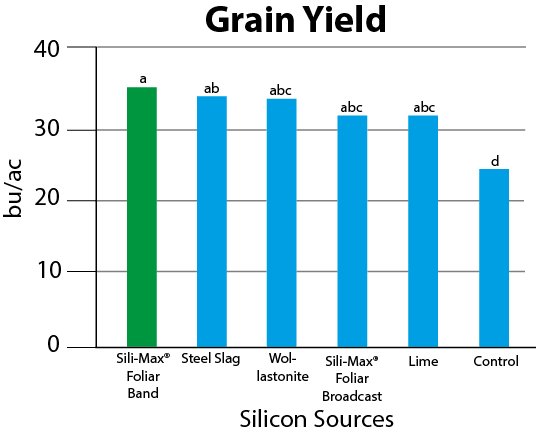Research by Brenda Tubana, PhD, Louisiana State University
The objective of this study was to compare, for use in Louisiana wheat production, the efficacy of a liquid silicon (Si) fertilizer (Huma Gro® Sili-Max®) with a commonly used dry Si source (steel slag) and another Si source (wollastonite) often used in research as a suspension. Silica deposition is an important barrier for foliar fungal diseases.
The wheat field study was conducted at Louisiana Ag-Center Research Stations. Silicon (Si) treatments were replicated four times and arranged in a randomized block design. There were 2 Huma Gro® Sili-Max® (10% Si) treatments (as a foliar band, and as foliar broadcast sprayed evenly over the entire plot). Each treatment was applied twice within 2 weeks at the onset of internode elongation (Feekes growth stage 5). The dry silicon sources (wollastonite [23% Si] and steel slag [11% Si]) were applied and incorporated into the soil prior to planting. Wheat leaf samples were collected one week after the application of silicon solution sources and evaluated for silica bodies (phytolith) deposition and percentage using scanning electron microscopy and energy dispersive x-ray analysis.

The accumulated silica bodies (phytolith) were 0.69% and 0.60% with Sili-Max® foliar broadcast and Sili-Max® foliar band treatments, respectively while the control had 0.53%.
Conclusions
Huma Gro® Sili-Max® applied as foliar band at a rate 3,900 times less than the dry silicon sources contributed to higher grain yield and straw yield, while the application of Sili-Max® as a foliar broadcast at a rate 1,900 times less than the dry silicon sources led to high Si deposition in wheat leaves.
Related Posts

Liquid Sili-Max® Improves Wheat Yield at Much Higher Efficiency Than Conventional Dry Silicon Fertilizers
Research by Brenda Tubana, PhD, Louisiana State University The objective of this study was to compare, for use in Louisiana wheat production, the efficacy of a liquid silicon (Si) fertilizer (Huma Gro® Sili-Max®) with a commonly used dry Si source (steel slag) and another Si source (wollastonite) often used in research as a suspension. Silica deposition is an important

Subscribe to “The Huma Gro Farmer” Podcast
Subscribe to The Huma Gro® Farmer podcast, in which we discuss crop nutrition and crop protection with experts in the field. Your host, Larry Cooper, interviews agronomists, certified crop advisors, and Huma Gro® distributors and customers about proven Huma Gro® programs and strategies for growing premium, high yield crops. Subscribe through your favorite smart-phone podcast

Promax® Efficacy in Controlling Strawberry Pathogens
Plant Sciences, Inc., conducted an independent study to test the efficacy of Promax® for inhibiting mycelial growth of 8 fungal strawberry pathogens through in vitro bio-assay. The following 8 fungi and fungal-like pathogens were tested: Botrytis cinera Colletotrichum acutatum Cylindrocarpon destructans Fusarium oxysporum f. sp. fragariae Macrophomina phaseolina Phytophthora ramorum Rhizoctonia solani Verticillium dahlia After

